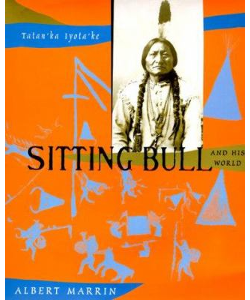Sitting Bull and His World

Author:
Albert Marrin
Publication:
2000 by Dutton Children's Books
Genre:
Biography, Non-fiction
Pages:
256
Current state:
Basic information has been added for this book.
It is under consideration and will be updated when it is evaluated further.
Book Guide
Search for this book used on:
TATAN'KA IYOTA'KE—Sitting Bull—was arguably the Plains Indians' most revered, most visionary leader—one who, by the example he set with his life, influenced Native Americans for generations to come.
A great Hunkpapa Lakota warrior, in 1876 Sitting Bull presided over the largest alliance of Northern Plains Indians ever assembled. With Crazy Horse and Gall, he led those thousands to defeat General Custer at the Battle of the Little Bighorn, a victory that fulfilled his prophetic vision of "soldiers falling into camp". For Sitting Bull was more than a chief. He was a holy man and seer, an astute judge of men, a singer and speaker for his people's ways. Withstanding the ravages wrought by the army, the railroad, the discovery of gold, and the abuses of Washington, he led his band to Canada rather than come in to the white man's reservations.
To render Sitting Bull in context, Albert Marrin delves into the differences between white and Indian cultures during the nineteenth century. He vividly illuminates the forces at work—economic pressures, racism, technology, postwar politics—that led to the creation of a continental nation at the expense of an entire people. Dr. Marrin's richly researched narrative poignantly illustrates how the lands stretching westward from the Mississippi River to the Rocky Mountains were gained by a combination of force and fraud, hard work and courage, broken treaties and bad faith—and good intentions gone terribly wrong.
"I am sorry indeed your skin is like mine, that your hair is like mine, and that every one around you is a pure red man like myself. We too have lost our country by falsehood and theft," Sitting Bull said to the remnants of the Nez Percé Indians who managed to make it across the Canadian border into his camp. Some six years later—after the deliberate annihilation of the buffalo forced Sitting Bull to lead his starving followers onto a reservation—he told a group of Indian children in an agency school, "We need you to help us understand what the white men are up to. My Grandchildren, be good. Try and make a mark for yourselves. Learn all you can."
From the dust jacket
To view an example page please sign in.
Content Guide
Please sign in to access all of the topics associated with this book and view other books with the same topics.
Please sign in to access the locations this book takes place in and view other books in the same location.
Please sign in to access the time periods this book takes place in and view other books in the same time period.
For information about the lead characters please sign in.
Find This Book
Search for this book used on:


